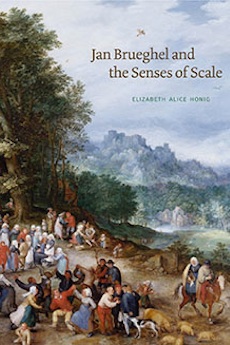By Svetlana Alpers
We are living at a moment when, it seems to me, there is weakened interest and confidence in the pictorial interest and scope of historical European art and its study. There are two reasons for this: first, the sense that Europe should be eclipsed by consideration of art as a global matter, and second, the sense that the assumptions about the nature of art installed in and instilled by traditional (European) art history are wanting. Some form of deconstruction and distraction is underway.
Elizabeth Honig’s book emerges from, and reminds one of, the strengths of the great tradition of art historical practice past and brings its practice into the present. The Flemish artist Jan Brueghel (1563-1625) was the youngest son of the famous Pieter Brueghel. What was his relationship to his father? The answer is put succinctly here: “Jan isn’t really modernizing his father’s style: he is rendering it irrelevant.” Jan has been overlooked because he does not fit the established notion of the canonical art, the so-called Baroque art, of his time. That art featured monumental figures displayed on large canvases. Brueghel is not Rubens, nor is he Caravaggio. They were big and rhetorical; he was detailed and modest. But he was admired and collected, as Honig points out, by the same patrons who favored those two “great” masters. What did they see in him?
The book begins with a definition of Brueghel’s paintings: they fail to conform to an established model of pictorial distance; they cleave close to particular bodies; they are the product of multiple hands; multiple hands held them when looking at them. Viewers did not stand back, they moved up close and held the small works in their hands. His works are at once material object (often painted on copper) and mimetic illusion. They offer an intimate experience. The paintings assume in their beholders what Honig calls “a visual subjectivity.”
While Bruegel specialized in painting things at a small scale, he was also at ease working with Rubens by supplying the settings and surrounding elements for his grand figures. His work offered a productive contrast to Rubens whose studio was nearby in Antwerp. If Rubens was uniquely able to combine the detailed style of the northern Europe tradition (think of Pieter Bruegel) with the large expressive figure style of Italy (think Raphael or Titian), Bruegel was singularly persistent in the northern mode on its own. Quick to distinguish her approach from those who have sought to define Brueghel’s work by the “philosophical” attitudes of his patrons, Honig focuses on how the paintings were made and the kinds of aesthetic experience they evoke.
If this all is new to a reader, Honig deftly sets the scene of his early years when he made his fame in Italy where he was collected by Cardinal del Monte who was also a fan of Caravaggio. Honig uses a period word, diligenza, (a word Brueghel used about himself) to define his work. It was the alternative to facility, another period term at a time when there was (as there is not today) a developed vocabulary with which to attend to art. In marvelously fluid, descriptive paragraphs, Honig surprisingly insists that despite his diligence, Brueghel’s work is not dry, but indeed what one might call painterly.
Honig is exemplary in providing the terms and ways of looking appropriate to this major-minor master—whether he is painting flowers, or landscapes or, most improbably, great historical subjects. In order to paint historical subjects, she argues, he shrinks the monumental and condenses the infinite. A problem is that Brueghel and his studio produced many works, and he himself worked together with so many other painters that they challenge attempts at definitive attributions. Which are actually by his hand? Does it matter? The production of his studio calls into question a belief in the master’s hand in new ways. And Honig’s account proposes that one thinks of collaboration between painters in terms of a sociability of visual thought.
The writing in this book is wonderful. The voice in her prose keeps one engaged, interested, reading attentively all the way through. The writing is highly crafted, but the impression one gets is that the thinking is going on right before one on the page. The flexible itemizing details of the writing are a perfect match for Brueghel’s paintings as she sees them, making it a book for the reading and for the looking.
In the end (and at the end of the book) I remain less convinced than Honig about the achievement of Jan Brueghel—and in particular less enthralled than she is by collaborative pictorial efforts. But she has made the most historically cogent and pictorially compelling argument that can be made for Brueghel’s work. To read the book is to see his strikingly different kind of ambitious painting with new eyes and to consider that historic painting can differ from the unique iconic masterpieces one looks for made by masters both old and new.
Svetlana Alpers, an artist, critic and renowned art historian, is professor emerita of the history of art at the University of California, Berkeley and a visiting scholar in the Department of Fine Arts at New York University.




